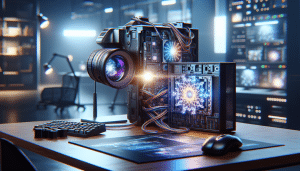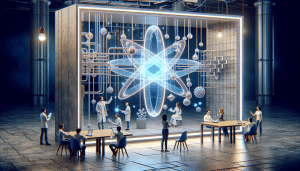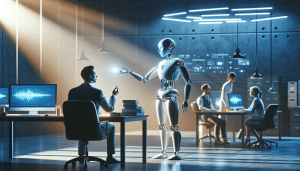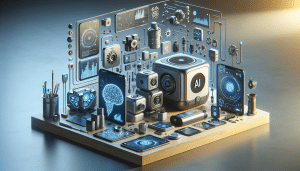AI in Everyday Life You May Not Notice Yet
Aiden Foster September 20, 2025
Artificial intelligence is woven into daily routines, often without much notice. Explore how machine learning, smart devices, and automation are quietly transforming everything from personal health to online recommendations—illustrating just how integrated tech advancements really are.
AI Personal Assistants Enhance Daily Routines
Many people engage with AI personal assistants such as Siri, Alexa, or Google Assistant regularly, sometimes without even realizing the complexity involved. Voice recognition and natural language processing empower these tools to understand queries, set reminders, and manage household devices. The seamless integration of artificial intelligence in these assistants has made them reliable partners for setting schedules, retrieving information, and guiding users through daily activities (Source: https://www.nist.gov/artificial-intelligence).
These AI-powered applications have gone beyond simple voice commands. Modern personal assistants can differentiate between voices, adapt responses based on user habits, and provide tailored suggestions. This personalization stems from complex algorithms analyzing data patterns, refining responses over time for each user. The rapid development in deep learning fuels the effectiveness and constant evolution of such AI tools in the home.
Integration with smart home ecosystems maximizes the utility of voice assistants. Lights, thermostats, and security systems can now be controlled remotely or scheduled based on AI-generated routines. Personal safety and comfort are improved, while machine learning quietly ensures systems adapt to user preferences, demonstrating how artificial intelligence shapes daily home environments.
AI Powers Smarter Healthcare Interactions
Machine learning-driven applications are revolutionizing healthcare with features like symptom checkers, virtual appointments, and health monitoring. AI platforms can evaluate user data, provide real-time guidance, and alert both patients and medical professionals about irregular patterns. Remote wearable devices, for instance, collect and analyze health data to detect changes that may require attention, sparking clinical intervention when necessary (Source: https://www.nih.gov/health-information/artificial-intelligence-health-care).
With advanced algorithms, healthcare AI offers personalized recommendations and reminders tailored to individual conditions and behaviors. Over time, these digital health tools help support users in managing chronic conditions and encourage adherence to medication or lifestyle plans. The application of predictive analytics helps identify high-risk patients, streamlining intervention and leading to better health outcomes.
Furthermore, AI supports diagnostic decision-making by sifting through vast databases of patient records, imaging, and research. By highlighting patterns a human might not spot, artificial intelligence assists medical staff in reaching more accurate diagnoses swiftly. This technology shortens wait times, enhances accuracy, and allows providers to focus attention where it matters most in patient care.
Automated Transportation and AI Navigation
Intelligent vehicle systems and navigation apps use AI to process real-time traffic, road hazards, and preferred user routes. Features like adaptive cruise control, lane-keeping, and predictive navigation demonstrate practical applications of artificial intelligence. These systems frequently update based on changing conditions, making travel smoother and helping drivers arrive faster and safer (Source: https://www.transportation.gov/artificial-intelligence).
Beyond private cars, AI is transforming public transit and logistics systems through scheduling algorithms, on-demand services, and predictive maintenance. Trains, buses, and shipping networks now use advanced analytics to minimize delays, optimize routes, and reduce resource waste. Many urban travelers rely on smart transport apps that recommend the most efficient ways to get around the city based on continuously updated information.
Self-driving car efforts highlight the intersection of AI, sensor fusion, and robotics. Although fully-autonomous vehicles aren’t the norm, partially automated features such as self-parking, emergency braking, and detection of nearby obstacles are currently available and improve safety. This is just a glimpse into how artificial intelligence continues to shape the future of mobility.
Content Recommendations Driven by Machine Learning
Streaming platforms and social media use sophisticated algorithms to suggest content based on viewing habits, search history, and engagement. These machine learning models continuously refine recommendations, blending personal interests with trending topics. This keeps users engaged and often introduces them to new music, series, or creators matching their taste (Source: https://ai.google/research/).
Recommendation systems go far beyond suggesting what to watch or read. Online shopping, news, and even job hunting platforms tailor results using artificial intelligence to predict what might interest users. This customization makes for efficient browsing and saves time, while also giving content creators and businesses a better chance of reaching interested audiences.
Feedback loops are key to the effectiveness of AI recommendations. Each interaction teaches the model to improve. The more users interact, the sharper and more attuned these predictions become. Though sometimes invisible, these systems are a powerful example of machine learning’s influence on digital experiences and decision-making.
Security Systems Adopt AI for Smarter Protection
Modern security relies heavily on AI-powered surveillance and authentication technologies. Facial and voice recognition, anomaly detection, and predictive alerts are now central to both public and private safety strategies. Cameras equipped with deep learning can distinguish between regular and suspicious activity, helping authorities focus resources effectively (Source: https://www.nist.gov/programs-projects/artificial-intelligence-and-cybersecurity).
Biometric authentication on smartphones and laptops is another example. These systems analyze unique patterns in fingerprints, irises, or facial features, offering secure access to devices and online accounts. Artificial intelligence helps spot potential threats, preventing unauthorized use even if someone tries to mimic stored biometric data. Security tools are constantly adapting to new risks thanks to continuous learning models.
Cybersecurity products deploy AI to monitor, detect, and respond to threats at a speed unattainable by humans. Networks benefit from real-time analysis, identifying phishing schemes, unusual logins, or malware faster than before. This increased intelligence serves as an evolving layer of digital protection, ensuring personal data and business assets are more secure than ever.
AI-Assisted Creativity in Art and Communication
Artificial intelligence is fueling creativity in both art and written communication. Tools that generate music, edit photos, or enhance writing are built on AI platforms capable of style transfer and pattern recognition. Visual artists use AI to filter, remix, and imagine entirely new visual worlds that extend beyond human limitations (Source: https://www.sciencedaily.com/releases/2022/10/221013114209.htm).
Writers, too, leverage technology to compose, summarize, and even translate content quickly. Natural language generation helps streamline customer communication, power virtual chatbots, and offer writing suggestions. The result is faster, more dynamic publishing and a democratization of creative expression that fosters innovation across fields.
These creative AI tools are not just for professionals. Hobbyists and everyday users can experiment with digital painting, music production, or blog writing using intuitive interfaces powered by machine learning. The accessibility of these resources showcases how deeply AI is woven into the fabric of personal creativity and self-expression.
References
1. National Institute of Standards and Technology. (n.d.). Artificial Intelligence. Retrieved from https://www.nist.gov/artificial-intelligence
2. National Institutes of Health. (n.d.). Artificial Intelligence in Health Care. Retrieved from https://www.nih.gov/health-information/artificial-intelligence-health-care
3. U.S. Department of Transportation. (n.d.). Artificial Intelligence. Retrieved from https://www.transportation.gov/artificial-intelligence
4. Google AI Research. (n.d.). Research. Retrieved from https://ai.google/research/
5. National Institute of Standards and Technology. (n.d.). Artificial Intelligence and Cybersecurity. Retrieved from https://www.nist.gov/programs-projects/artificial-intelligence-and-cybersecurity
6. National Science Foundation. (n.d.). Artificial Intelligence. Retrieved from https://www.nsf.gov/cise/ai.jsp








